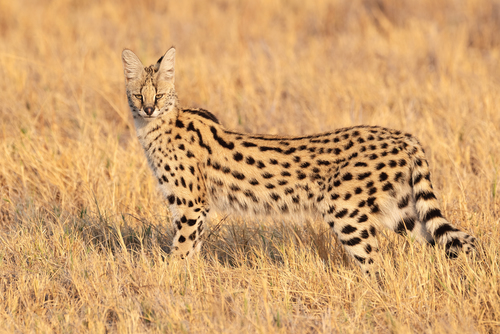
Serval
The serval, with its striking golden coat and elongated legs, thrives in Africa's savannas. Masterful hunters, these solitary cats use their oversized ears to detect prey, leaping up to 3 meters to capture birds mid-flight, playing a critical role in controlling rodent populations.
10-20 years
Lifespan
3.5 - 19.0 kg
Weight
Length: 60 - 100 cm
Size
Brown, Yellow, Black, White, Orange
Color
18-24 months
Age of Sexual Maturity
5 months
Age of Weaning
40 mph
Top Speed
Least Concern
Conservation Status
Stable
Population Trend
Characteristics
The serval is a medium-sized, slender cat native to sub-Saharan Africa. It is characterized by its long legs, large ears, and a golden-yellow coat with black spots and stripes. Servals are solitary and primarily nocturnal, known for their exceptional hunting skills and ability to leap high to catch prey.
Distribution Range of the Serval
The serval (Leptailurus serval) is native to Africa, primarily found in the sub-Saharan regions. Its geographical distribution includes countries such as South Africa, Botswana, Namibia, Angola, Zambia, Mozambique, Tanzania, and Kenya. The species is notably absent from the dense rainforests of Central Africa and the arid deserts of the Sahara.
Serval's Habitat
Environmental Conditions
Servals inhabit various environments but are most commonly found in regions with abundant water sources. They thrive in savannas, wetlands, and grasslands where tall grasses and reeds provide cover. These areas typically feature warm climates with some seasonal rainfall, supporting a diverse range of prey animals.
Ecological Niche
The serval's ecological niche is that of a medium-sized carnivorous mammal. It is a solitary and territorial predator primarily preying on small mammals, birds, frogs, insects, and fish. The serval's long legs and large ears are well-adapted for hunting in tall grass environments, allowing it to detect and pounce on prey effectively. Its preference for wetland and savanna habitats is linked to the availability of prey and suitable cover for hunting.
Copyright @ Nature Style Limited. All Rights Reserved.
 English
English